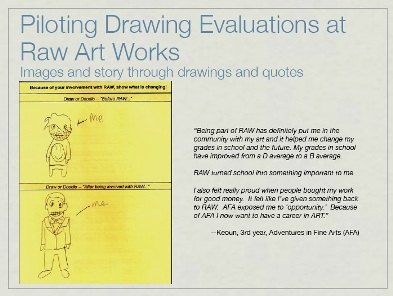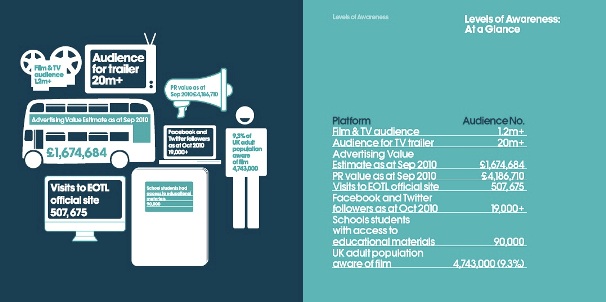
Renan Snowden
How Art Can Strengthen Evaluation
Posted by May 04, 2012 2 comments

Renan Snowden
Let’s be honest: sometimes evaluation can feel like taking medicine. What's more, the results of evaluation often take the form of dry reports that are unwelcoming and, at worst, hard to penetrate. But evaluation doesn’t have to be this way.
Evaluation can be a useful and engaging process that incorporates creativity and participation to help an organization learn how it can more effectively reach its goals. Evaluation presents an opportunity for arts organizations to demonstrate the impact they are making in their communities. Incorporating artistic practice and a combination of narrative documentation and compelling graphics can make evaluation interesting and build off of an arts organization’s existing skill set.
Artists and arts organizations have an advantage with evaluation: you want it to be a creative process. Right now, some arts organizations are taking the lead in including drawing, storytelling, and graphic design as part of their evaluation process and reporting.
By making evaluation a creative and dynamic process, these organizations are helping make assessment more attractive to practitioners by showing that evaluation can build off the work your organization already has expertise in.
As a graduate student in urban planning, I’m interested in ways that the arts can help create shared spaces for community development. Writing short summaries of the in-depth resources available on the Animating Democracy website as the spring IMPACT intern, I began to notice that some of the best case studies of measuring the impact of social change incorporated the arts as part of the evaluation process. These innovative approaches to evaluation are facilitating new ways of evaluation that emphasize experience and engagement as key components of evaluation.
The Boston Youth Arts Evaluation Project
Arts can break down barriers and encourage participants to provide creative and unfiltered responses. The Boston Youth Arts Evaluation Project (BYAEP) developed and implemented an evaluation process spearheaded by five youth arts organizations in Boston. Working together with community and evaluation experts, BYAEP created an evaluation rubric that spoke directly to their needs. What’s more, they incorporated a before and after artistic response that enabled young people to evaluate the programming they had participated in. Rather than conduct formal focus groups, they invited the young people who participated to use photography, drawing, poetry, or creative writing to provide feedback.
Tucson Pima Arts Council and the Center for Digital Storytelling
Arizona's Tucson Pima Arts Council (TPAC) incorporated ethnography into its evaluation of the Finding Voice project with the help of University of Arizona researcher Maribel Alvarez. Their case study, Two Way Mirror, describes how ethnography in their evaluation approach prioritized observation, documentation, and dialogue as critical aspects of their evaluation process. By encouraging those doing the evaluation work to hear stories and conduct long-form interviews, TPAC made capturing stories a benchmark of the success of their evaluation.
Want to learn how to use documentary techniques and narratives to measure impact? The Center for Digital Storytelling (CDS), an international nonprofit training, project development, and research organization dedicated to assisting people and organizations in using digital media to tell meaningful stories. Stories prove time and again to be a highly potent form for conveying the nature and effects of arts for change work. Animating Democracy has observed that digital stories are a new norm—an efficient and inexpensive method that can go a long way to enhance in-person and online visibility, campaigns, and case making. These videos are also great for sharing with your funders and supporters through social media, newsletters, and email campaigns.
Here’s one example of CDS’ work with the California Film Institute (CFI). CFI’s My Place program trains youth in San Francisco, Alameda, and Marin counties to write, direct, and edit their own short films about their every day experiences with friends, family, and their community.
The End of the Line, Documentary Film
All too often, the results of evaluations get lost in the back of annual reports. Raise the level of awareness of your results by showing off your results with innovative graphic design work. The End of the Line, a documentary about the devastating impact of overfishing the world’s oceans, completed a thorough evaluation of their efforts to make an impact and change habits and policy decisions. In addition to evaluations with focus groups, measuring social media analytics, and press coverage, the filmmakers created a dynamic report that grabs viewers and simplifies the takeaways from the results.
Part of what makes the results from the report compelling is the visual punch of their analysis. Take a look at this page from their report. Imagine if the information on impact was only presented in a list format, like on the right side. Now pay attention to the dynamism of the left side of the page with different shapes and sizes. Which one grabs your attention and makes you pay attention?
The left side also has a greater chance of getting picked up on blogs, retweeted, shared, used as a conference slide, or understood by a broad audience due to its memorable design. Using art and graphic design to display your results is more attention-grabbing than just listing your results. You’ve worked hard on your evaluation. Compelling visual design makes it easy for to share your results with your supporters and demonstrate the impact of your work for social change.
Incorporating creative response, using storytelling as an evaluation tool, and enlisting graphic design are three ways to encourage creativity as an active component of evaluation assessments.
Artists and arts organizations can play to their strengths by infusing creative expression throughout the evaluation process. Many evaluators are already working closely with arts organizations to incorporate artistic practices to measure social impact.
What methods have you used to include art and design as a part of your evaluation process?




Comments
Obviously the left side rocks (and the right side s___s). So when will we finally get evaluation tools (excel, SPSS, SAS, SenseMaker, NVIVO, etc) that spit out visual results instead of text and spreadsheets? Art imitates life, but evaluations are slaves to time and software.
I'm tired of waiting. I think I'll go build what I want now...
Evaluating work of art is not a simple undertaking, for example, taking a gander at a depiction and saying it stinks with the primary look or that it's extraordinary inside the main sight. A few things should be considered while evaluating art at buy essay online cheap. The time allotment when the fine art was created and area is two great focuses to consider. An oil painting from a youthful grown-up in a tribe in Africa would catch more enthusiasm than my niece's work of art in California that did her artwork in third period workmanship class. Which would emerge to catch intrigue? I would think a territory that isn't known for utilizing a particular media for work of art.